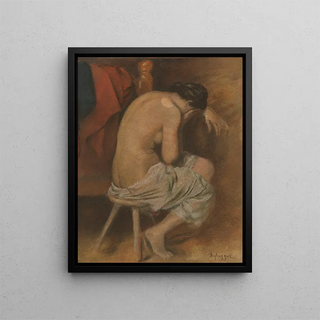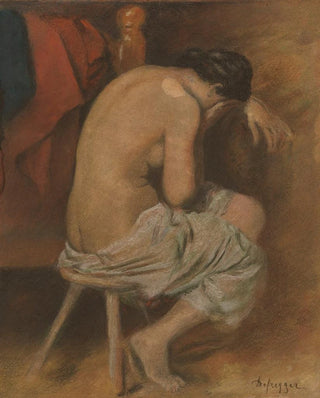Art print Rückenakt - Franz von Defregger | Art print


View from behind

Frame (optional)
Rückenakt Art print - Franz von Defregger – Engaging introduction
The artwork "Rückenakt" by Franz von Defregger is an iconic piece that embodies the very essence of 19th-century artistic realism. This painting, distinguished by its depiction of a delicate yet powerful female silhouette, invites viewers to contemplate not only the beauty of the human body but also the intimacy of a moment frozen in time. Through this work, Defregger manages to capture the grace of a pose while evoking an atmosphere of serenity and contemplation. The way light caresses the shapes and contours of the model transports us to a universe where art and life meet harmoniously.
Style and uniqueness of the work
Defregger's style is characterized by meticulous realism and a keen attention to detail. In "Rückenakt," each brushstroke seems to vibrate with subtle energy, paying homage to the beauty of the female form. The texture of the skin, the play of shadows and light, as well as the delicacy of the drapery, demonstrate impressive technical mastery. The piece stands out not only for its precision but also for the emotion it conveys. The posture of the model, turned towards the viewer while maintaining a certain distance, creates a visual tension that provokes thought and invites reflection. Defregger succeeds in establishing a dialogue between the subject and the observer, making this work both personal and universal.
The artist and his influence
Franz von Defregger, born in 1835 in Austria, is an artist whose work marked his era. Influenced by the great masters of painting, he developed a unique style that combines tradition and innovation. His passion for representing the human body and scenes of daily life allowed him to make a name for himself within the realist movement. Defregger was able to capture the soul of his models, whether peasants, women, or children, often drawing inspiration from alpine culture, which is reflected in his works. His impact on Austrian art is undeniable, and he paved the way for many artists who followed in his footsteps, seeking

Matte finish

View from behind

Frame (optional)
Rückenakt Art print - Franz von Defregger – Engaging introduction
The artwork "Rückenakt" by Franz von Defregger is an iconic piece that embodies the very essence of 19th-century artistic realism. This painting, distinguished by its depiction of a delicate yet powerful female silhouette, invites viewers to contemplate not only the beauty of the human body but also the intimacy of a moment frozen in time. Through this work, Defregger manages to capture the grace of a pose while evoking an atmosphere of serenity and contemplation. The way light caresses the shapes and contours of the model transports us to a universe where art and life meet harmoniously.
Style and uniqueness of the work
Defregger's style is characterized by meticulous realism and a keen attention to detail. In "Rückenakt," each brushstroke seems to vibrate with subtle energy, paying homage to the beauty of the female form. The texture of the skin, the play of shadows and light, as well as the delicacy of the drapery, demonstrate impressive technical mastery. The piece stands out not only for its precision but also for the emotion it conveys. The posture of the model, turned towards the viewer while maintaining a certain distance, creates a visual tension that provokes thought and invites reflection. Defregger succeeds in establishing a dialogue between the subject and the observer, making this work both personal and universal.
The artist and his influence
Franz von Defregger, born in 1835 in Austria, is an artist whose work marked his era. Influenced by the great masters of painting, he developed a unique style that combines tradition and innovation. His passion for representing the human body and scenes of daily life allowed him to make a name for himself within the realist movement. Defregger was able to capture the soul of his models, whether peasants, women, or children, often drawing inspiration from alpine culture, which is reflected in his works. His impact on Austrian art is undeniable, and he paved the way for many artists who followed in his footsteps, seeking
12,34 €






